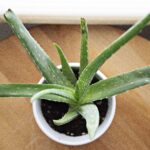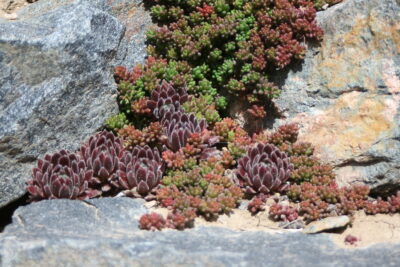
Easy Guide to Propagating Jelly Bean Succulents at Home

Jelly Bean Succulents, also known as Sedum rubrotinctum, are popular houseplants due to their unique appearance and low maintenance needs. Native to Mexico, these succulents are characterized by their plump, jelly bean-shaped leaves that change color depending on the amount of sunlight they receive. With their vibrant hues and compact growth habit, they make for stunning additions to any indoor or outdoor garden.
We will provide an easy guide on how to propagate Jelly Bean Succulents at home. Propagation is the process of creating new plants from existing ones, and it is a great way to expand your succulent collection or share these beautiful plants with friends and family. We will cover the different methods of propagation, including leaf and stem cuttings, as well as provide step-by-step instructions on how to successfully propagate Jelly Bean Succulents. Additionally, we will discuss the ideal conditions for propagation and offer tips for caring for the new plants until they are ready to be placed in their permanent homes.
- Choose a healthy jelly bean succulent plant
- Gently remove a few leaves from the bottom of the plant
- Allow the leaves to dry for 2-3 days until calloused
- Prepare a well-draining soil mix for the new plants
- Place the calloused leaves on top of the soil mix, pressing them gently into the soil
- Mist the leaves with water to keep them hydrated
- Place the container in a bright but indirect sunlight location
- Keep the soil lightly moist, but not overly wet
- After a few weeks, roots and new plants will begin to grow from the base of the leaves
- Once the new plants have grown a few inches, they can be transplanted into their own pots
- Continue to care for the new plants by providing them with appropriate light, water, and soil conditions
- Enjoy watching your collection of jelly bean succulents grow and thrive
- Frequently Asked Questions
Choose a healthy jelly bean succulent plant
Choose a healthy jelly bean succulent plant
Before you can start propagating jelly bean succulents at home, it's important to choose a healthy plant as your starting point. Look for a jelly bean succulent that has vibrant, plump leaves and no signs of damage or disease. This will ensure that your propagated plants have the best chance of thriving.
What to look for:
- Plump leaves: Opt for a plant with leaves that are full and chubby. This indicates that the plant is well-hydrated and healthy.
- No damage: Check the leaves and stems for any signs of damage, such as cuts or bruises. A plant without any physical damage is more likely to successfully grow new roots.
- No pests: Inspect the plant closely for any signs of pests, such as mealybugs or spider mites. These can hinder the propagation process and potentially harm your other plants.
Where to find a jelly bean succulent:
You can find jelly bean succulents at your local plant nursery, garden center, or even online. Make sure to choose a reputable source that sells healthy plants. If possible, ask for advice from the staff to ensure you're selecting the right plant for propagation.
Now that you've chosen a healthy jelly bean succulent, you're ready to move on to the next step in the propagation process.
Gently remove a few leaves from the bottom of the plant
 Discover the Succulents with Shallow Root Systems for Easy Care
Discover the Succulents with Shallow Root Systems for Easy CarePropagating jelly bean succulents is a rewarding and simple process that allows you to expand your succulent collection at home. One easy way to propagate these adorable plants is by removing a few leaves from the bottom of the parent plant. This method is suitable for both beginners and experienced plant enthusiasts.
To get started, choose a healthy jelly bean succulent with mature leaves. Look for leaves that are plump and vibrant in color, as these indicate a well-nourished plant. It's important to select leaves that are not damaged or diseased to ensure successful propagation.
Using a clean, sharp pair of scissors or a sterilized knife, gently remove several leaves from the bottom of the parent plant. It's crucial to make clean cuts to avoid damaging the plant. Aim to remove leaves that are fully grown and have a firm attachment to the stem. Avoid pulling the leaves off as this can cause unnecessary stress to the plant.
Pro tip: It's advisable to remove leaves from different areas of the plant to ensure a more balanced propagation.
Once you have your chosen leaves, place them on a clean surface and let them dry for a few days. This drying period allows the cut edges of the leaves to callus, which helps prevent rotting and promotes healthy root growth.
Pro tip: Make sure to keep the leaves away from direct sunlight during the drying process to avoid sunburn or dehydration.
After the leaves have callused, prepare a well-draining potting mix suitable for succulents. You can use a combination of cactus soil and perlite or pumice to create a light and airy mix. Fill a small container with the potting mix, leaving enough space for the leaves to be inserted without touching the sides.
 Can You Propagate Succulents by Cutting and Replanting the Cuttings?
Can You Propagate Succulents by Cutting and Replanting the Cuttings?Pro tip: Adding a thin layer of coarse sand or small pebbles at the bottom of the container can further enhance drainage.
With a gentle touch, insert the dried leaves into the potting mix, burying the cut ends about half an inch deep. Ensure that the leaves are positioned upright and not tilted to promote healthy growth. It's recommended to space the leaves apart to allow adequate airflow and prevent overcrowding.
Pro tip: You can use a pencil or a chopstick to create holes in the potting mix before inserting the leaves, making it easier to bury them without damaging their delicate structure.
Place the container in a bright location with indirect sunlight. Avoid exposing the newly propagated leaves to direct sunlight as this can cause sunburn or overheating. Maintain a consistent temperature between 70-80°F (21-26°C) to provide optimal conditions for root development.
Water the propagated leaves sparingly, misting the potting mix lightly to keep it slightly moist. Overwatering can lead to root rot, so it's essential to find the right balance. As the leaves begin to develop roots and new growth, you can gradually increase the amount of water.
Pro tip: Using a spray bottle with a fine mist setting can help distribute water evenly without causing excessive moisture.
With patience and proper care, you will start to notice tiny roots emerging from the buried ends of the leaves after a few weeks. This is a sign that your jelly bean succulent propagation is successful! As the roots develop, you can gradually transition the new plants into their individual pots with well-draining soil.
 Can Succulents Develop New Roots from Their Stems?
Can Succulents Develop New Roots from Their Stems?Pro tip: Be gentle when transplanting the propagated leaves into separate pots to avoid damaging the delicate roots.
Now that you know how to propagate jelly bean succulents, you can enjoy the satisfaction of growing a thriving succulent garden at home. Get creative and experiment with various propagation methods to expand your collection and share the beauty of these delightful plants with others!
Allow the leaves to dry for 2-3 days until calloused
Propagating jelly bean succulents at home is a fun and rewarding way to expand your succulent collection. One of the most important steps in the process is allowing the leaves to dry for 2-3 days until they form a callous. This callous acts as a protective layer and helps prevent rotting when the leaves are planted.
Prepare a well-draining soil mix for the new plants
One of the crucial steps in successfully propagating jelly bean succulents is to ensure that they are planted in a well-draining soil mix. This is because these plants are native to arid regions and are adapted to thrive in sandy or gritty soil.
To create an ideal soil mix for your jelly bean succulents, start by combining equal parts of potting soil and perlite. Potting soil provides the necessary nutrients, while perlite improves drainage and prevents the roots from sitting in excess moisture.
For those who prefer a DIY approach, you can make your own succulent soil mix by combining two parts of regular potting soil, one part perlite, and one part coarse sand. The coarse sand helps to further enhance the drainage properties of the soil mix.
 Discover the Best Online Sources for High-Quality Succulent Seeds
Discover the Best Online Sources for High-Quality Succulent SeedsIt's important to note that jelly bean succulents are prone to root rot if they are exposed to overly moist conditions for an extended period. Therefore, ensuring that the soil is well-draining is crucial for the health and survival of these plants.
Pro tip: If you're unsure about the moisture levels in your soil mix, consider adding a layer of small rocks or pebbles at the bottom of the pot. This will provide additional drainage and prevent water from accumulating at the roots.
Place the calloused leaves on top of the soil mix, pressing them gently into the soil
Place the calloused leaves on top of the soil mix, pressing them gently into the soil
Propagating jelly bean succulents, also known as Sedum rubrotinctum, is a simple and rewarding process that allows you to expand your succulent collection without having to spend a fortune. One of the most effective methods of propagating these adorable plants is by using their leaves.
To start, prepare a well-draining soil mix by combining equal parts of potting soil and perlite or coarse sand. This will ensure that the roots of the propagated leaves do not become waterlogged, preventing rot and promoting healthy growth.
Once you have your soil mix ready, it's time to select the leaves for propagation. Look for healthy leaves that are plump and firm, without any signs of damage or disease. Gently twist or cut the leaves off the mother plant, ensuring that you have a clean break.
Place the calloused leaves on top of the soil mix, making sure that the bottom end is in contact with the soil. Press them gently into the soil, ensuring that they are stable and won't topple over. It's important to note that you should not bury the entire leaf, as this may hinder root development.
 Will Succulent Leaves Regrow If They Fall Off: The Complete Guide
Will Succulent Leaves Regrow If They Fall Off: The Complete GuideNote: you can propagate multiple leaves in a single container, as long as they have enough space between them to allow for growth.
Once you have placed the leaves in the soil, it's time to provide them with the optimal conditions for successful propagation. Find a bright spot with indirect sunlight, as direct sunlight may scorch the leaves. Maintain a temperature range of 65-75°F (18-24°C) and ensure good air circulation.
Water the soil lightly, just enough to keep it barely moist. Overwatering can lead to rot and hinder the rooting process. Mist the leaves occasionally to provide some humidity, but be careful not to overdo it, as excessive moisture can cause fungal issues.
Now, it's time to be patient. It may take a few weeks or even months for the leaves to develop roots and form tiny rosettes at the base. During this period, resist the temptation to disturb the leaves or check for root growth too frequently. Trust the process and let nature take its course.
Tip: To prevent the leaves from getting knocked over or moved, you can cover the container with a plastic dome or place it in a sealed plastic bag. This will create a mini greenhouse effect and help maintain the necessary humidity.
Once the propagated leaves have developed a sufficient root system and new growth, it's time to gently transfer them into their individual pots. Use a similar well-draining soil mix and plant them at the same depth as they were in the propagation container.
Continue to care for the young jelly bean succulents by providing them with adequate sunlight, watering sparingly, and allowing the soil to dry out between waterings. With time and proper care, your propagated jelly bean succulents will grow into beautiful and thriving plants.
 Succulents: Growing from Seeds or Cuttings?
Succulents: Growing from Seeds or Cuttings?Now that you know how to propagate jelly bean succulents easily, give it a try and watch your succulent collection flourish!
Mist the leaves with water to keep them hydrated
Propagating Jelly Bean Succulents
If you're a succulent enthusiast looking to expand your collection, propagating jelly bean succulents at home is a fun and rewarding project. These adorable plants, also known as Sedum rubrotinctum, are known for their plump, jelly bean-like leaves that change color throughout the year.
Propagating jelly bean succulents is relatively easy and can be done using a few simple methods. Whether you prefer leaf propagation or stem cuttings, this easy guide will walk you through the steps to successfully propagate your own jelly bean succulents.
Leaf Propagation
Leaf propagation is a popular method for propagating succulents, and jelly bean succulents are no exception. Here's how you can do it:
- Select healthy leaves: Choose a healthy jelly bean succulent and gently pluck a few leaves from the stem. Make sure to select leaves that are plump and free from any damage.
- Allow callus formation: Place the leaves in a dry and shaded area, away from direct sunlight. Let them sit for a few days or until a callus forms at the base of the leaves. This callus will help prevent rotting during the rooting process.
- Prepare a well-draining soil mix: Fill a small container or tray with a well-draining soil mix suitable for succulents.
- Plant the leaves: Gently press the callused end of the leaves into the soil, ensuring that the base is in contact with the soil. Mist the leaves with water to keep them hydrated.
- Provide indirect sunlight: Place the container in a spot that receives bright, indirect sunlight. Avoid exposing the leaves to direct sunlight, as it may scorch them.
- Keep the soil lightly moist: While succulents don't require frequent watering, it's essential to keep the soil lightly moist during the initial stages of propagation. Be careful not to overwater, as this can cause rotting.
- Wait for roots to develop: Over time, tiny roots will start to emerge from the base of the leaves. This indicates that the leaf has successfully taken root.
- Transplant the rooted leaves: Once the roots have developed, gently transplant the rooted leaves into individual pots filled with a well-draining succulent soil mix.
Stem Cuttings
If you prefer a quicker method of propagating jelly bean succulents, stem cuttings are an excellent option:
- Select a healthy stem: Choose a healthy stem from your jelly bean succulent. Look for a stem that is firm and free from any signs of damage or disease.
- Cut the stem: Using a clean and sharp pair of scissors or gardening shears, carefully cut a section of the stem just below a leaf node. The cutting should be around 2-3 inches long.
- Callus formation: Similar to leaf propagation, allow the cut end of the stem to dry and callus over for a few days.
- Prepare a well-draining soil mix: Fill a small pot with a well-draining soil mix suitable for succulents.
- Plant the cutting: Gently insert the cut end of the stem into the soil, ensuring that the node is covered and secure in the soil.
- Provide indirect sunlight: Place the pot in a location that receives bright, indirect sunlight. Avoid exposing the cutting to direct sunlight, as it may cause sunburn.
- Water sparingly: While the cutting establishes roots, water sparingly to avoid overwatering. It's crucial to keep the soil lightly moist but not soggy.
- Root development: With proper care and time, the cutting will develop roots and start to grow new leaves.
- Transplant the cutting: Once the cutting has established roots and new growth, you can transplant it into a larger pot or container.
By following these simple steps, you can successfully propagate jelly bean succulents at home. Whether you choose leaf propagation or stem cuttings, be patient and provide the necessary care for your new plants. With time, you'll have a beautiful collection of jelly bean succulents to enjoy!
 Gentle Techniques for Removing Succulent Offshoots
Gentle Techniques for Removing Succulent OffshootsPlace the container in a bright but indirect sunlight location
When it comes to propagating jelly bean succulents at home, it is important to provide them with the right amount of sunlight. These plants thrive in bright but indirect sunlight, so it is crucial to find the perfect spot for them.
Choose a location in your home that receives ample natural light throughout the day. Avoid placing the container in direct sunlight as it can cause the leaves to burn or become discolored. Instead, opt for a spot near a window or in a well-lit room.
Remember that the intensity of sunlight varies throughout the day, so it is important to monitor the light levels in the chosen location. If the light is too harsh, consider using sheer curtains or blinds to filter the sunlight and create a more suitable environment for the jelly bean succulents.
By providing the right amount of bright but indirect sunlight, you can ensure that your jelly bean succulents receive the necessary energy to grow and thrive.
Keep the soil lightly moist, but not overly wet
Proper watering is crucial when it comes to propagating jelly bean succulents. These plants have shallow roots and are prone to root rot if the soil remains too wet for an extended period. On the other hand, if the soil becomes too dry, the succulents may not receive enough water to support growth.
To strike the right balance, aim to keep the soil lightly moist. Water the succulents when the top inch of the soil feels dry to the touch. Avoid overwatering, as excess water can lead to root rot and other issues. It's better to underwater than to overwater these plants.
 Learn How to Successfully Propagate Your Black Rose Succulent
Learn How to Successfully Propagate Your Black Rose SucculentWhen watering your jelly bean succulents, it's important to water directly at the base of the plant. Avoid wetting the leaves, as this can lead to fungal diseases and other problems. Ensure that the water drains out properly from the pot to prevent waterlogged soil.
During the winter months or when the succulents are in a dormant phase, reduce watering frequency to prevent excessive moisture in the soil. Remember, these plants are adapted to survive in arid conditions, so they prefer drier soil.
As a general rule of thumb, it's better to underwater than to overwater your jelly bean succulents. They can tolerate short periods of drought, but prolonged exposure to excess moisture can be detrimental to their health.
After a few weeks, roots and new plants will begin to grow from the base of the leaves
One of the most fascinating aspects of propagating jelly bean succulents is witnessing the growth of new plants from the base of the leaves. This process may take a few weeks, but it is well worth the wait.
When you first start propagating jelly bean succulents, you will notice tiny roots emerging from the base of the leaves. These roots are a sign that the plant is establishing itself and seeking nutrients from the soil. It is essential to provide adequate moisture and sunlight during this stage to ensure optimal growth.
 Step-by-Step Guide: How to Successfully Propagate Succulents at Home
Step-by-Step Guide: How to Successfully Propagate Succulents at HomeAs the roots continue to develop, small plantlets will start to emerge. These plantlets are essentially miniature versions of the parent plant, complete with their own set of leaves. This is an exciting milestone in the propagation process, as it signifies successful root development and the beginning of independent growth.
It is important to handle these delicate plantlets with care, as they are still fragile at this stage. Avoid touching them directly and try to support them by gently holding the base of the leaf. Gradually, these plantlets will grow larger and stronger, eventually transforming into fully-grown jelly bean succulents.
Remember to provide regular care and maintenance to these new plants, including watering, adequate sunlight, and occasional fertilization. With proper attention, your propagated jelly bean succulents will thrive and bring vibrant beauty to your indoor or outdoor space.
So, be patient and enjoy the mesmerizing process of watching roots and new plants emerge from the base of the leaves. It's a rewarding experience that allows you to expand your succulent collection and share the beauty of jelly bean succulents with others.
Once the new plants have grown a few inches, they can be transplanted into their own pots
Transplanting your propagated jelly bean succulents into their own pots is an exciting step in their growth journey. It allows them to have more space to thrive and prevents overcrowding. Here's an easy guide on how to successfully transplant your jelly bean succulents:
- Choose the right pot: Select a pot that is slightly larger than the current one, ensuring it has drainage holes to prevent waterlogged soil. This will help promote healthy root growth.
- Prepare the potting mix: Use a well-draining cactus or succulent potting mix. You can also create your own mix by combining regular potting soil with perlite or coarse sand.
- Remove the succulent from its current pot: Gently tap the sides of the pot to loosen the soil and carefully lift the succulent out, holding it by the base. Be cautious not to damage the roots.
- Inspect the roots: Check the roots for any signs of rot or damage. Trim off any unhealthy or dead roots using a clean pair of scissors or pruning shears.
- Place the succulent in the new pot: Create a small hole in the center of the potting mix and gently place the succulent's roots into it. Ensure that the base of the succulent is level with the rim of the pot.
- Backfill with potting mix: Carefully fill the gaps around the roots with the potting mix, pressing it gently to secure the plant in place. Avoid compacting the soil too tightly, as it can hinder water drainage.
- Water and settle: Give the newly transplanted succulent a thorough but gentle watering, allowing the water to soak through the potting mix. This helps settle the soil and removes any air pockets around the roots.
- Find the ideal spot: Place the potted succulent in a location with bright, indirect sunlight. Avoid exposing it to direct sunlight, especially during the hottest parts of the day.
- Maintain proper care: Regularly monitor the moisture levels of the soil and water the succulent only when the top inch of the soil feels dry. Overwatering can lead to root rot, so be cautious.
Following these steps will ensure a smooth transition for your propagated jelly bean succulents into their new pots. With proper care and attention, they will continue to grow and bring beauty to your indoor or outdoor space.
 The Cause of Tall Growth and Limited Spreading in Succulents
The Cause of Tall Growth and Limited Spreading in SucculentsContinue to care for the new plants by providing them with appropriate light, water, and soil conditions
Once you have successfully propagated your jelly bean succulents, it's important to continue providing them with the right care to ensure their health and growth. Here are some tips on how to care for your new plants:
Light
Jelly bean succulents thrive in bright, indirect sunlight. Place them near a window where they can receive at least 4-6 hours of sunlight per day. If you notice your plants stretching or becoming leggy, it might be an indication that they are not getting enough light. In that case, consider moving them to a spot with more sunlight.
Water
When it comes to watering jelly bean succulents, it's important to strike a balance. These plants prefer to be slightly underwatered rather than overwatered. Allow the soil to dry out completely between waterings and then water thoroughly until water drains out of the drainage holes. Avoid leaving the plants sitting in standing water as it can lead to root rot.
During the winter months, when the plants go into a dormant phase, reduce watering frequency as they require less water during this time.
Soil
Jelly bean succulents prefer well-draining soil to prevent the roots from sitting in water for too long. You can use a cactus or succulent potting mix or create your own by combining regular potting soil with sand or perlite to improve drainage.
It's also important to repot your jelly bean succulents every few years to refresh the soil and provide them with fresh nutrients.
Fertilizer
Jelly bean succulents do not require frequent fertilization. You can use a balanced, liquid succulent fertilizer diluted to half strength and apply it once or twice during the growing season. Avoid fertilizing during the winter months when the plants are dormant.
Pests and Diseases
Jelly bean succulents are generally resistant to pests and diseases. However, they can occasionally attract mealybugs or spider mites. Keep an eye out for any signs of infestation, such as sticky residue or tiny webs, and treat the problem promptly using organic pest control methods.
Note: It's important to remember that these care guidelines are general recommendations, and individual plant needs may vary. Always monitor your plants closely and make adjustments as necessary.
By providing your newly propagated jelly bean succulents with the right care, you can enjoy watching them grow and thrive in your home. With a little patience and attention, you'll soon have a stunning collection of these unique and colorful succulents.
Enjoy watching your collection of jelly bean succulents grow and thrive
If you're a succulent enthusiast looking to expand your collection, propagating jelly bean succulents at home is an easy and rewarding way to do so. With their unique round-shaped leaves that resemble jelly beans, these succulents, also known as Sedum rubrotinctum, are not only visually appealing but also relatively low-maintenance.
What is propagation?
Propagation is the process of creating new plants from existing ones, allowing you to grow your succulent collection without having to purchase new plants. Jelly bean succulents can be propagated through various methods, including leaf cuttings and stem cuttings.
Leaf cuttings
To propagate jelly bean succulents using leaf cuttings, follow these simple steps:
- Choose a healthy leaf from your existing jelly bean succulent.
- Using a clean, sharp knife or scissors, carefully remove the leaf from the stem, ensuring that you have a clean break.
- Allow the leaf cutting to dry out for a few days until a callus forms over the cut end. This helps prevent rotting when planted.
- Prepare a well-draining potting mix suitable for succulents.
- Place the calloused end of the leaf cutting into the soil, ensuring it is inserted about half an inch deep.
- Water the soil lightly, making sure not to overwater. Succulents prefer slightly drier conditions.
- Keep the soil moist but not saturated and place the pot in a bright, indirect light location.
- After a few weeks, you should start to see new roots and small rosettes forming at the base of the leaf cutting.
- Once the new plantlets have grown a bit, you can separate them from the original leaf and transplant them into their individual pots.
Stem cuttings
Another method to propagate jelly bean succulents is through stem cuttings:
- Choose a healthy stem from your existing jelly bean succulent.
- Using a clean, sharp knife or scissors, cut a section of the stem, ensuring it is a few inches long.
- Allow the stem cutting to dry out for a couple of days until a callus forms over the cut end.
- Prepare a well-draining potting mix suitable for succulents.
- Insert the calloused end of the stem cutting into the soil, burying it about an inch deep.
- Water the soil lightly, allowing it to drain well.
- Place the pot in a bright location with indirect sunlight.
- Over time, the stem cutting will develop roots and start producing new growth.
- Once the new plant is well-established, you can transfer it to its permanent pot.
Note: Whether propagating through leaf or stem cuttings, it's important to provide your new plants with proper care, including regular watering, well-draining soil, and adequate sunlight. With patience and attention, you'll soon have a beautiful collection of jelly bean succulents to enjoy in your home or garden.
Frequently Asked Questions
1. Can jelly bean succulents be propagated easily?
Yes, jelly bean succulents are relatively easy to propagate through stem cuttings or leaf cuttings.
2. When is the best time to propagate jelly bean succulents?
The best time to propagate jelly bean succulents is during the spring or summer months when they are actively growing.
3. How long does it take for jelly bean succulent cuttings to root?
It usually takes about 2-4 weeks for jelly bean succulent cuttings to develop roots and establish themselves.
4. What is the ideal growing medium for propagating jelly bean succulents?
A well-draining succulent or cactus mix is ideal for propagating jelly bean succulents as it helps prevent root rot.
If you want to read more articles similar to Easy Guide to Propagating Jelly Bean Succulents at Home, you can visit the Propagation category.






You Must Read